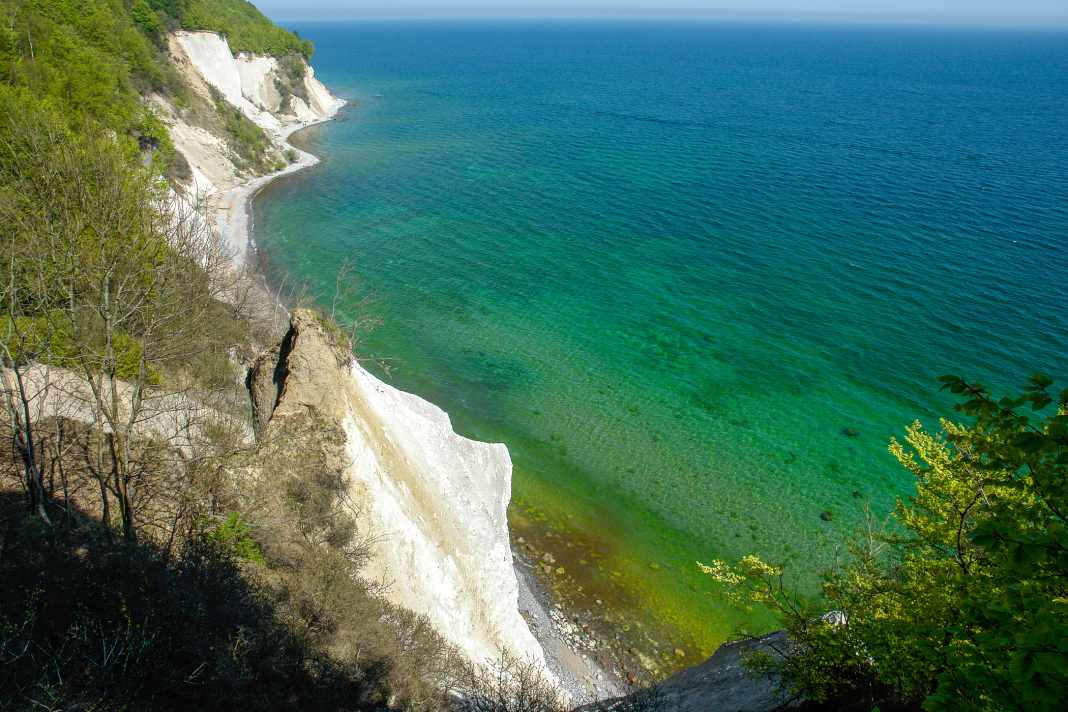





Cruising tips for Rügen:
National parks are retreats for plants and animals where nature is left to its own devices. At the same time, they attract millions of visitors every year precisely because of their unspoilt nature. And that is also the intention: As part of the conservation objectives, people should experience nature here and thus recognise its value and worthiness of protection.
The Jasmund National Park
On 12 September 1990, shortly before the official end of the GDR, the Jasmund National Park was founded on the island of Rügen. At 30 square kilometres, it is Germany's smallest national park. It is located in the east of the island of Rügen, between Sassnitz in the south and Lohme in the north. The impressive coastline with its snow-white chalk cliffs, which rise majestically above the blue sea, is world-famous. The chalk, which was deposited almost 70 million years ago, forms a steep shore that is unique in Germany. The national park area includes the wooded ridge of the Stubnitz, which rises up to 161 metres above the Baltic Sea, the steep banks and a 500 metre wide strip of the Baltic Sea in front of the beach.
Water sports and nature conservation
The Jasmund National Park consists of 20 per cent water areas. It is forbidden for watercraft to enter this 500 metre wide protected zone from the shore. The area provides a protected habitat for numerous species of fish and waterfowl. Highly endangered marine mammals such as the harbour porpoise and the grey seal find important refuges here. Rügen is one of the most beautiful cruising destinations in Western Pomerania, but nature in the national park takes centre stage. The breathtaking view of the chalk cliffs can also be enjoyed from a distance from the water.
Harbours and approach
Sassnitz: The former ferry harbour of Rügen now mainly serves as a fishing harbour and pleasure craft marina. There are numerous restaurants along the pier, as well as a fishing and harbour museum. Thanks to the wide, lighted entrance, which is protected by high piers, Sassnitz can be called at in any weather (www.stadthafen-sassnitz.de). The location is ideal for visiting the famous chalk cliffs from here. From the entrance to the Jasmund National Park on the outskirts of Sassnitz, it is a two-kilometre walk to the Wissower Klinken. However, anyone expecting the view through the white pinnacles as painted by Caspar David Friedrich in 1818 will be disappointed: on 24 February 2005, the fairytale-like chalk pinnacles slipped into the sea and were washed away by the Baltic Sea. It is easier to get to the Königsstuhl, a UNESCO World Heritage Site: Buses run from Sassnitz almost right up to the famous rock. Since 2023, there has been a futuristic viewing platform hovering above the famous chalk cliff.www.koenigsstuhl.com).
Lohme: The old fishing village is located at the northern end of the chalk coast. The harbour (Marina Lohme), which dates back to 1906, was modernised in 1997. There are not many places, especially for larger yachts, so you have to arrive early or trust your luck. The village is 50 metres higher up and can be reached via a steep staircase. Once at the top, you are rewarded with a magnificent view.
Myths and romance
The landscape of the Jasmund National Park is not only known for its natural beauty, but also for its numerous myths and legends. From Klaus Störtebeker, who is said to have hidden his treasure here, to damsels in distress or rulers who are said to have watched battles from here, there are many stories surrounding the famous chalk cliffs. By the time of the Romantic period at the latest, they had become familiar to many. The most prominent representative of this era is Caspar David Friedrich, who created a monument to this place with his painting "Chalk Cliffs on Rügen".
Paradise for nature lovers
Rügen is a paradise for hikers. The largest beech forests on the Baltic coast entice you to take long walks on land. 493 hectares of the "old beech forests" are recognised as a UNESCO World Heritage Site. The Hochuferweg trail between Sassnitz and Lohme is considered one of the most beautiful and spectacular hiking trails on the Baltic Sea. From the famous Königstuhl you have a unique view of the surrounding coastal area, the so-called Stubbenkammer. At the Königstuhl National Park Centre, visitors can experience the fascination of this special landscape on three floors. The new Skywalk opened in April 2023: a barrier-free, suspended viewing platform above Germany's highest chalk cliff, which is included in the entrance fee to the National Park Centre.

